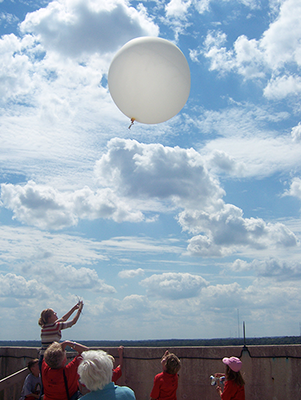
Radiosondes are instrument packages that measure the vertical profiles of air temperature, relative humidity, and pressure from the ground all the way up to about 19 miles. These radio-equipped meteorological instrument packages are carried aloft by a helium-filled “weather balloon.” Temperature and relative humidity are measured electronically and a small aneroid barometer measures pressure. The tracked position of a radiosonde (technically called a rawinsonde observation) is used to obtain wind speed and direction. At low air pressures in the stratosphere, the balloon expands so much that it explodes and the radiosonde drifts back to the ground underneath a small parachute.
Weather forecasting requires making observations and predicting changes by solving a complex set of equations that describe the physics and dynamics of our atmosphere. Accurate observations at a specific time over a large geographic region are critical to making accurate weather predictions. Radiosondes provide needed information that forecasters and computer models use to determine current weather and make accurate weather forecasts. The National Weather Service normally, and historically, launches radiosondes twice daily (00 and 12 UTC, or 5 a.m. and 5 p.m. CST) in about 100 locations across the US territory. These measurements are combined with observations from across the globe made at the same time. These upper air measurements, or soundings, provide critical weather observations that cannot be gotten any other way. These soundings are particularly valuable as severe weather bears down on a location.
The large budget cuts recently imposed by the current administration have resulted in massive job cuts, as well as a reduction in weather balloon launches at several sites across the US. Knowing less about the current state of the atmosphere will impact forecast accuracy. Also, the suspended weather balloon launches impact the weather forecast downstream from where it is launched. The missing observations will impact the quality of the forecasts of major and impactful weather events.
Steve Ackerman and Jonathan Martin, professors in the UW-Madison department of atmospheric and oceanic sciences, are guests on WHA radio (970 AM) at noon the last Monday of each month. Send them your questions at stevea@ssec.wisc.edu or jemarti1@wisc.edu.

